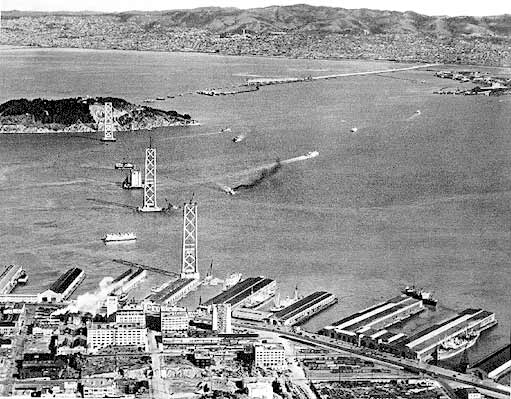We hope you will enjoy your visit to our Museum.
If you do, please help us out with a tax deductable donation.
Donate
The March of Steel

From opposite shores, men and steel converge on Yerba Buena Island, the fulcrum of
the San Francisco-Oakland Bay Bridge. This photograph, snapped two thousand
feet in the sky from the good airplane Flying A, brings the mighty project into a
most interesting perspective.
Deep in the center foreground is the San Francisco cable anchorage, eye-bars in place, all
set for the strain cables and their great weight. Just beyond it is Pier W-1, the land pier,
two giants columns of concrete—less spectacular but no less important that the
steel ones that overlook it.
At the foot of Embarcadero’s Pier 24, is bridge Pier W-2 rearing its tower four hundred
seventy-eight feet above high water, five hundred eighty feet above its rock
foundations. This is the first of the steel towers. Ferry boats, sea-going steamers, study
tugs are pygmies by comparison.
Over a half mile further is W-3, and this tower, like the one yet to be raised on W-5, rises
five hundred twenty-two feet above the surface of the Bay.
W-4, mighty colossus of concrete, will be crowned with no steel crest. W-4 is the great
central pier, the cable anchorage and marrying point of the two suspension bridges that
combine to span the two miles of water between San Francisco and Yerba Buena.
Beyond it and the stub of W-5 is W-6, built where the tides flow deepest, and the pier
extends one hundred eighty feet below water to rock bottom. This is the newest of all the
towers.
A quarter mile away yawns the huge bore of Yerba Buena’s tunnel. From its lip westward
will swing the cables and over W-6 and her three sisters.
East of Yerba Buena tunnel the causeway will swing right and up again in a bee-line for
Oakland’s busy down-town.
Of a different type of construction is this section of the bridge—cantilever. And
the first unit is to be one of the heaviest cantilever structures in the world. There’s not a
cable in it—just strong steel girders. Already a double deck of steel reaches out a
third of the way alongside the Key Route pier.
For background there is to the right, Oakland Mole, famed point of embarkation for San
Francisco. Back and left is Oakland. Then Berkeley, and persons
bay-region-wise will pick out University of California’s Memorial Stadium
and the spire-like Campanile in the center of the background.
Away over the Contra Costa hills is a large part of San Francisco Bay’s prosperous
hinterland, the great Sacramento and San Joaquin Valleys soon to become closer to San
Francisco because of the bridge.
Such is the picture today—each girder, each rivet of the bridge a monument to
progress in the West, also to the quality and efficiency of Cycol motor oils and greases and
Flying A gasoline—Associated products that protect and power the unceasing
machines of construction.
ASSOCIATED OIL COMPANY
Return to the Associated Oil Co. Exhibit
Next Portfolio
|

